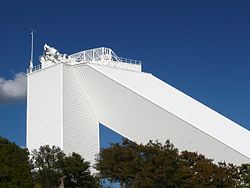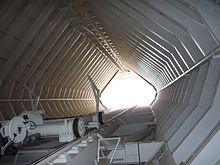- McMath-Pierce Solar Telescope
-
McMath-Pierce Solar Telescope  The McMath-Pierce Solar Telescope in Tucson, Arizona.
The McMath-Pierce Solar Telescope in Tucson, Arizona.Organization National Solar Observatory Location Kitt Peak, Arizona Coordinates 31°57′30.3″N 111°35′40.83″W / 31.958417°N 111.594675°WCoordinates: 31°57′30.3″N 111°35′40.83″W / 31.958417°N 111.594675°W[1] Altitude 2096m Weather 72% clear nights Wavelength Optical and infrared Built 1960–1962 Telescope style Prime focus reflecting telescope Diameter 161 cm Angular resolution 0.07 arcsec @ 500nm (theoretical) Collecting area 2.04 m² Focal length 82.62 m Mounting Equatorial mount with heliostat Dome Slanted tower Website http://nsokp.nso.edu/mp/ The McMath-Pierce Solar Telescope is a 1.6-m f/54 reflecting solar telescope at Kitt Peak National Observatory in Arizona, USA. The building was designed by Myron Goldsmith and built in 1962. It is the largest telescope of its kind in the world and is named for astronomers Robert McMath and Keith Pierce. At the dedication in 1962, Dr. Waterman read a letter[2] from President Kennedy starting with:
“ The great new solar telescope at the Kitt Peak National Observatory in Arizona is a source of pride to the nation. The largest instrument for solar research in the world, it presents American astronomers with a unique tool for investigating the nearest of the stars, our sun. This project is of exceptional interest to all our citizens... ” Contents
Construction
The telescope contains a heliostat at the top of its main tower which focuses the sun's light down a long shaft. The distinctive diagonal shaft continues underground, where the telescope's primary mirror is located. The theoretical resolution of this main telescope 0.07 arcsec, although this is never reached because atmospheric distortions degrade the image quality severely. The image scale is 2.50 arcsec/mm at the image plane.
In addition to this 1.6-meter primary mirror, there are also an East- and West-auxiliary telescope which are completely independent of the main telescope. These two auxiliary telescopes both have a 0.91-meter heliostat which are located beside the main heliostat. These auxiliary telescopes have a slightly shorter focal length and f-numbers of 50 and 44. The resolution of the auxiliary telescopes is 5.11 arcsec/mm and 5.75 arcsec/mm.
Instruments
The third mirror of the main telescope which sends the light down into the observing room can be moved above three different positions. Two of these have a vacuum spectrograph beneath them, one of 18 meter deep and the other 4 meter deep with lower resolution but higher light throughput. These two spectrographs are able to rotate to compensate for the rotation of the image caused by the use of a heliostat. The third position can only be equipped with a static optical table with no image rotation correction and is therefore rarely used.
The auxiliary telescopes can only be used for imaging on static optical tables and do not provide image rotation correction.
References
- ^ Technical information
- ^ "NSO/KP History of the MP Facility". http://nsokp.nso.edu/mp/history.html. Retrieved 2008-05-16.
External links
- Kitt Peak virtual tour: McMath-Pierce Solar Telescope
- "McMath Solar Telescope of the Kitt Peak National Observatory", A. K. Pierce, Applied Optics, 3, 1337-1346, 1964.
- A History of the McMath-Pierce Solar Telescope
- Schematic diagram of the McMath-Pierce telescope
- Adaptive optics at the McMath-Pierce telescope
See also
- List of solar telescopes

This article related to the Sun is a stub. You can help Wikipedia by expanding it.



